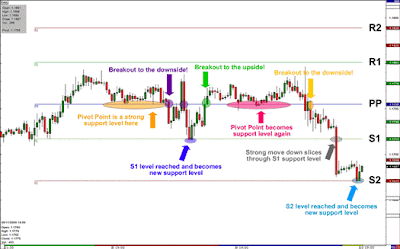Breakout Trades
The pivot point should be the first place you look at to enter a trade, since it is the primary support/resistance level. The biggest price movements usually occur at the price of the pivot point.
Only when price reaches the pivot point will you be able to determine whether to go long or short, and set your profit targets and stops. Generally, if prices are above the pivot it’s considered bullish, and if they are below it’s considered bearish.
Let’s say the price is hovering around the pivot point and closes below it so you decide to go short. Your stop loss would be above PP and your initial profit target would be at S1.
However, if you see prices continue to fall below S1, instead of cashing out at S1, you can move your existing stop-loss order just above S1 and watch carefully. Typically, S2 will be the expected lowest point of the trading day and should be your ultimate profit objective.
The converse applies during an uptrend. If price closed above PP, you would enter a long position, set a stop loss below PP and use the R1 and R2 levels as your profit objectives.
Range-bound Trades
The strength of support and resistance at the different pivot levels is determined by the number of times the price bounces off the pivot level.
The more times a currency pair touches a pivot level then reverses, the stronger the level is. Pivoting simply means reaching a support or resistance level and then reversing. Hence, the word “pivot”.
If the pair is nearing an upper resistance level, you could sell the pair and place a tight protective stop just above the resistance level.
If the pair keeps moving higher and breaks out above the resistance level, this would be considered an upside “breakout”. You would also get stopped out of your short order but if you believe that the breakout has good follow-through buying strength, you can reenter with a long position. You would then place your protective stop just below the former resistance level that was just penetrated and is now acting as support.
If the pair is nearing a lower support level, you could buy the pair and place a stop below the support level.
Theoretically Perfect?
In the real world, pivot points don’t work all the time. Price tends to hesitate around pivot lines and at times it’s just ridiculously hard to tell what it will do next.
Sometimes the price will stop just before reaching a pivot line and then reverse meaning your profit target doesn’t get reached. Other times, it looks like a pivot line is a strong support level so you go long only to see the price fall, stop you out, then reverse back into your direction.
You must be very selective and create a pivot point trading strategy that you intend to strictly follow.
Let’s go look at a chart to see just how difficult and easy pivot points might be.
Look at the orange oval. Notice how the PP was a strong support but if you went long on PP, it never was able to rise up to R1.
Look at the first purple circle. The pair broke down through PP but failed to reach S1 before reversing back to PP. On the second break down though (second purple circle), the pair did manage to reach S1 before once again reversing back to PP.
Look at the pink oval. Again, PP acted as strong support but never was able to rise up to R1.
On the yellow circle, the pair broke out to the downside again, sliced right through S1, and managed to fall all the way down to S2.
If you ever attempted to go long on this chart, you would have been stopped out every single time. Personally, we would have not even thought about buying this pair - Why not? Well we have a little secret. What we didn’t show you regarding this chart was that this pair was trending down for quite some time now. Remember the “trend is your friend”.





No comments:
Post a Comment